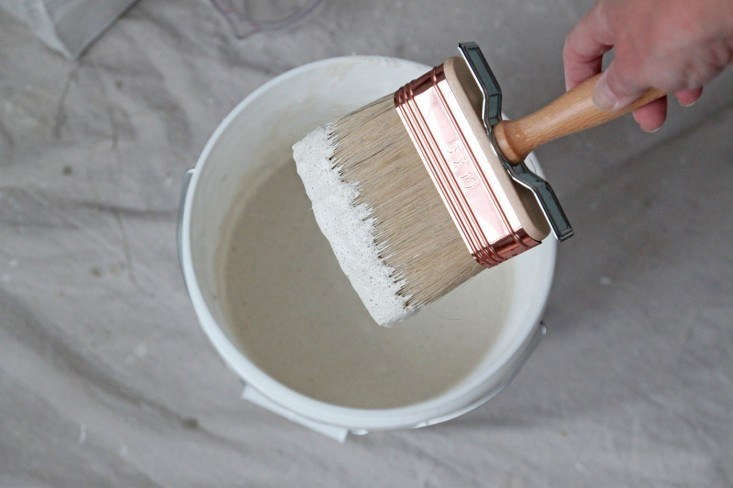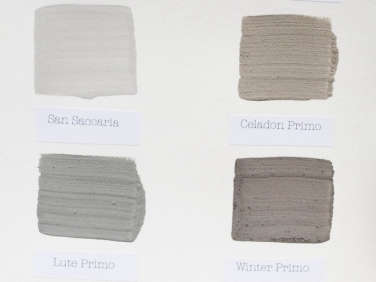When it comes to paint, do the Belgians know best? Mineral-based, natural limewash is a Belgian basic with a chalky, nuanced texture that only gets better with age. Environmentally friendly and used for centuries, limewash is one of the original house paints. Should it be on your short list?

What is limewash?
An ancient house staple dating back to Roman times, limewash is made from limestone that’s been crushed, burned, and mixed with water to make a lime putty. The putty is aged and then thinned with water and colored with natural pigments. Limewash creates surfaces that are mottled and matte with a chalky texture something like suede. It lends a depth and luminosity to flat walls.

Is limewash environmentally friendly?
Free of solvents that have pushed paints to the top of the household environmental hazards list, traditional limewash is made from natural lime and natural pigments. Even some modern varieties that contain additional binding agents use mineral additives that keep the environmentally-friendly attributes intact.
Lime’s high pH level means microorganisms can’t survive, which adds a hypoallergenic quality. Proponents also argue that limewash has a chemical makeup that removes odors (and harmful CO2), improving interior air quality.

Where can I use limewash?
Limewash can be used indoors and out. Unlike most house paints that sit atop surfaces, limewash sinks in, so it’s best applied to porous surfaces, such as plaster, stone, and brick. That said, limewash (especially premade, modern varieties that may already have mineral-binding additives) can be applied to drywall as long as an appropriate primer is used. The key is to go with a mineral-based primer–such as an acrylic primer (used often under latex paints)–that creates a surface the limewash can bond to.

What colors does limewash come in?
In its base form, limewash is off-white. Color is achieved by adding natural, alkali-resistant pigments, which are available in shades dictated by what the earth has to offer. Browns, grays, and taupes are the norm.

Keep in mind that limewash becomes much lighter as it dries. It’s up to 10 times darker when it’s wet; so it’s important to test colors. The opacity depends on the number of coats that are applied; typically up to three coats are recommended. This is a paint that requires an openness to chance. Colors vary depending on the pigments used, the composition and porosity of the surface being painted, and the application of the paint.

Where can I get limewash?
Though much more common in Europe than the US, limewash (with and without colorants added) is available from several manufacturers. Sydney Harbour Paint Company, the North American arm of Australia’s Porter Paints, offers Exterior Lime Wash, as well as an interior lime-based, natural paint line called Interno Lime Wash in a wide range of shades. BioLime has a variety of lime paint that can be used indoors and out. New to the US, Kalklitir Natural Lime Wash from Sweden is offered in a small but gorgeous collection of colors from Antica Collection, in Houston, Texas. RomaBio comes without color additives. They are specifically designed to be tinted with Natural Oxide Earth Pigments.

Can I make my own limewash?
Mixing your own limewash is the budget-friendly way to go. It’s a simple process that involves making a lime putty from hydrated lime (available at hardware stores) mixed with water, and then gradually diluting the concoction with water until it has the consistency of thick cream. Natural pigments are added for color. See DIY Project: Limewashed Walls for Modern Times for our tutorial.


How is limewash applied?
Limewash should be applied in several thin coats using a long-haired or masonry paintbrush that creates feathered strokes. Never use a roller. Kalklitir of Sweden’s “How to Apply Lime Color to a Wall” video details the application process and shows how the paint soaks in and dries.

How do I clean my limewashed walls?
Cleaning limewashed walls is not recommended, nor is it often required: Limewash’s mottled, shadowy effect shows much less dirt than standard painted surfaces do. But should walls need a touch-up, simply apply a diluted re-coat of limewash.

Limewash Recap
Pros
- Breathable (no condensation in damp conditions).
- Natural, solvent-free, and hypoallergenic.
- Absorbs odors.
- Naturally bacteria-resistant.
Cons
- Limited color palette.
- Mottled appearance hard to control and not to everyone’s liking.
- May require several coats to get the desired effect.
- Not easily cleaned; may require a re-coat.

Our resident paint expert, Meredith, presents All You Need to Know about VOCs in Paint. Considering wallpaper instead? Alexa found a Handmade Wallpaper Inspired by Nature. And, see all our Palette & Paints Features.
For more paint advice:
- Expert Advice: 12 Questions to Ask a Painter Before You Hire ‘the One’
- Expert Advice: How to Hire a Truly Great Painter for Your Home
- 10 Paint Colors with Cult Followings: Architects’ All-Time Favorite Paint Picks
- Architects’ 8 Favorite Cool-Toned Neutral Paints
- Architects’ 8 Favorite Pure White Paints
N.B.: This post is an update; the original story ran on October 2, 2014.
Frequently asked questions
What is limewash?
Limewash is a type of paint that is made from a mixture of slaked lime, water, and natural pigments. It has been used for centuries to create a soft, matte finish on walls and has a unique, chalky appearance.
What are the advantages of using limewash?
Limewash offers several benefits. It creates a breathable finish that allows walls to "breathe," preventing moisture buildup and promoting healthy indoor air quality. Limewash also provides a natural and textured look, is environmentally friendly, and can be applied to a variety of surfaces, including plaster, brick, and stone.
Can I use limewash on interior and exterior walls?
Yes, limewash can be used on both interior and exterior walls. It is particularly popular for exterior applications, as it helps protect the walls from weathering and provides a beautiful, aged appearance. In interiors, limewash adds character and a sense of history to spaces.
How is limewash different from traditional paint?
Limewash is different from traditional paint in several ways. Unlike regular paint, which forms a film on the surface, limewash penetrates the substrate and forms a chemical bond with the material. It also has a more translucent and textured finish compared to the opaque and smooth finish of regular paint.
Can I apply limewash directly to any surface?
Limewash is most commonly applied to porous surfaces such as plaster, brick, and stone. These materials allow for better adhesion and breathability. Before applying limewash, it's important to ensure the surface is clean, free from loose debris, and properly prepared to promote good adhesion.
Can I change the color of limewash?
Yes, the color of limewash can be customized by adding natural pigments. This allows for a range of color options, from traditional white and off-white shades to earthy tones like ochre, sienna, or charcoal. The amount of pigment added can be adjusted to achieve the desired hue.
How long does limewash last?
The longevity of limewash depends on several factors, including the quality of the application, the porosity of the surface, and the exposure to weather conditions. Generally, limewash develops a beautiful patina over time but may require touch-ups or reapplication every few years to maintain its appearance.










Have a Question or Comment About This Post?
Join the conversation